Nearly thirty years after its introduction in the 1980s, the Nuclear Winter hypothesis has gained additional quantitative confirmation, providing a robust argument for the illegality of nuclear weapons under the Law of Armed Conflict.
The Nuclear Winter hypothesis played a significant role in the reduction of nuclear weapon stockpiles between the Soviet Union and the US. Since the fall of the Soviet Union, international attention has been refocused upon other international problems such as climate change as well as ozone layer depletion. However, the effect of a Regional Nuclear War of only fifty 10-kiloton bombs upon the environment and the subsequent suffering produced by an abrupt change in the climate system, would be far more devastating than problems caused by greenhouse gasses and ozone depleting chemicals, including massive famine and migration, poisoning of water supplies, severe drops in temperature of up to 20 degrees below average, and the destruction of the biosphere and the stabilizing effects plants have on the climate.
Ironically, a nuclear conflict would both negate the effects of any greenhouse gas controls, while also creating a large amount of ozone depleting chemicals. With the climate system already near a “tipping point” it is possible that a nuclear conflict could create changes far worse than the general circulation models predict by quickly forcing the climate system into a new “regime” with terrifying consequences for agriculture. Because of the widespread, indiscriminate devastation that would be unleashed by a nuclear conflict, neither threat nor use of such weapons can be considered legitimate in light of the new certainty provided by recently updated models.
This paper will first present key pieces of international law as well as international treaties that govern the use of Nuclear Weapons with respect to their effect on the environment. It will also discuss the legitimacy of military operations which cause indiscriminate damage to the environment. It is divided into two parts: the legal underpinning of our argument, and the current scientific projections of effect of nuclear weapons on the environment and climate.
Legal Foundations and Environmental Arguments
The proliferation of nuclear weapons represents an existential threat which forces otherwise sovereign states, to also violate their treaty obligations and march towards the inevitable development of nuclear weapons. Rather than focusing on the tricky issues of development and the subtleties of the NPT, this paper will focus upon the use and threat of nuclear weapons, within the context of accepted rules of military operations. While those taking the position against nuclear weapons argued that the threat and use of nuclear weapons are governed by the Article 6 of the International Covenant on Civil and Political Rights, those arguing for the right to use nuclear weapons argued that the threat and use of weapons were governed by the law of armed conflict. The ICJ agreed with the latter position (Matheson).
Because the ICJ agreed with the position that Environmental Treaties, and Human Rights Treaties were overruled by the Laws of Armed Conflict with respect to the use of nuclear weapons, this section will argue that the environmental and human consequences of nuclear weapons violate the laws of armed conflict in important ways, particularly in light of the new scientific certainty regarding the after effects of a nuclear conflict, both through death and injury to non-combatant nations,as well as the long term degradation of food stocks and arable land which would devastate human civilization.
It is important to make the assertion that use and threat may not necessarily be distinct. According to the ICJ advisory opinion states “The notions of ‘threat’ and ‘use’ of force stand together—Possession of nuclear weapons, deterrence and threat. http://www.lcnp.org/wcourt/opinion.htm
The notions of “threat” and “use” of force under Article 2, paragraph 4, of the UN Charter stand together in the sense that if the use of force itself in a given case is illegal—for whatever reason—the threat to use such force will likewise be illegal. In short, if it is to be lawful, the declared readiness of a State to use force must be a use of force that is in conformity with the Charter. For the rest, no State—whether or not it defended the policy of deterrence—suggested to the Court that it would be lawful to threaten to use force if the use of force contemplated would be illegal. (ICJ para. 48 1996).
It follows that if the use of nuclear weapons are unlawful, then so is the threat to use a nuclear weapon. Thus, the lawful use of military force must be briefly explored to determine if the use of nuclear weapons violate laws governing rational military operations which rest on the rule of proportionality, the rule of necessity, and the rule of discrimination.
Under the rule of necessity, states must ensure that the force used is no greater that that which is necessary to attack to target (LCNP). Under the rule of proportionality, if the collateral civilian damage is excessive in relation to the military advantage then the action is illegal (Neuman). Finally the rule of discrimination requires that military attacks be able to distinguish between combatant states and neutral state. Regarding Neutrality, the US argued both that not all nuclear explosions cause material damage to neutral parties, though they also equivocated by stating that the law of discrimination merely prohibits the invasion or bombardment of non-combatant territories, though it does not guarantee against collateral damage.
Because the ICJ argues that the law of armed conflict supersedes other international treaties which might have jurisdiction over the use of Nuclear Weapons, and because the Court has not taken a strong position ruling out all use of nuclear weapons based on the laws of proportionality or necessity, the legality of such weapon may hinge the rule of discrimination or neutrality, which promises to limit collateral damage to neutral and friendly parties. The limits of acceptable collateral damage are left undefined by the ICJ, but are explicitly delineated in military manuals which treat Nuclear Weapons usage and acceptable levels of collateral damage. The USAF Intelligence Targeting Guide explicitly states that collateral damage must be limited so that friendly troops and populations have a 99% safety factor. In light of the new scientific evidence regarding the long term consequences of nuclear weapons, no use of nuclear weapons would fall within the parameters of acceptable collateral damage in the use of Nuclear weapons.
Even discounting the immediate damage caused by nuclear weapons, the use and threat of such armaments seems to violate the norms of military operations when the environmental destruction, and resulting human devastation upon friend and neutral troops and populations are considered. In addition to the immediate human costs of nuclear war, the far more devastating post-detonation global consequences would affect civilians regardless of nationality or allegiance for generations. As much as the initial blast of a nuclear detonation would produce indiscriminate, immediate casualties, the environmental consequences would cause global famine, mass migrations, and general degradation of living conditions for a vast majority of the world’s population.
An estimated 1 billion people could die due to the detonation of 100 Hiroshima sized warheads in even a localized regional war. Thus, those who use nuclear weapons cannot plausibly operate within accepted military procedures regarding collateral damage. The rule of discrimination also fails miserably in the case of nuclear weapons, since combatants and non-combatants would be affected with equally devastating consequences
Critics of the opponents of any legitimate use of nuclear weapons argue that damage from nuclear weapons can be limited in some cases, and simply cannot be predicted in others. Furthermore, arguments against unnecessary suffering also hinged on the idea that greater suffering can be prevented by the limited use of Nuclear weapons. However with improvements in the ability to predict environmental impacts of nuclear weapons it is now nearly impossible to ignore the fact that even a limited nuclear war would produce global consequences disproportionate to their military advantages, which would qualify as a war crime and crime against humanity, if the definition of acceptable collateral damage, as defined by the US military are used. Specifically, beyond a very small threshold, there is no radius of safety which may be established to prevent friendly or neutral troops from suffering massive casualties and collateral damage. This fact, undermines the arguments which support the use of nuclear weapons under the law of armed conflict, upon which the ICJ rests their advisory opinion.
Scientific Discussion:
The Nuclear winter hypothesis was first proposed by Turco et al in a 1983 paper entitled Nuclear Winter: Global Consequences of Multiple Nuclear Explosions in Science magazine. Turco’s co-authors included the well known astronomer and scientist Carl Sagan. Given the limited computing power to simulate scenarios, some controversy existed at the time about the accuracy of the severity of the nuclear winter models, with some critics of previous nuclear winter results suggesting that once uncertainties were addressed, the severity of the results would decrease. Thompson and Schneider (1986) coined the phrase Nuclear Autumn which provided some scientific backing for those in policy circles arguing that the theory of nuclear winter has been exaggerated and disproved (Martin, 1988).
The defense and nuclear research establishment quickly latched on to this mitigating theory to suggest further studies and modernization of the current nuclear arsenal. However, improved models and computing power have virtually eliminated the uncertainty about the consequences of a nuclear war. The effects of even a small nuclear exchange would produce globally devastating results which violate the laws of armed conflict.
The Nuclear Winter Hypothesis With Modern Computing Power.
Assessing the technical aspects of models and projections:
Since the 1980s, further simulations using improved models and computers reinforce the early conclusion that a large-scale nuclear conflict would have devastating climatic and environmental consequences. The general circulation models used by these scientists are good at predicting close range, future outcomes of climate, based upon the current climate. However, it is nearly impossible for these models to produce accurate results if the climate system shifts (Robock et al 1988). In our present circumstances, it is unknown whether the present system is not far enough removed from the climate system studied in the 1980s that a regime shift may occur due to the large destabilizing effects of a Nuclear Conflict. The first nuclear winter models were conducted by Turco et al. (1983) which only simulated the effects of nuclear smoke in a single 1 dimensional model.
These predictions were necessarily uncertain, leading some to criticize the theory and giving the nuclear establishment the ability to simply dismiss the studies by conducting more studies. After these single column studies, scientist began to employ larger datasets and General Circulation Models (GCM) which incorporate precipitation, temperature, and wind data, along with sophisticated mathematical models which simulate atmospheric dynamics and physics on a grid which represents coordinates of the planet. Covey et al. (1984) and Thompson (1985) used the National Center for Atmospheric Research atmospheric GCM and confirmed the results of the Soviet scientists Aleksandrov and Stenchikov (1983). Later studies by Turco et al. (1990) gave further confirmation to Turco et al. (1983) results.
The initial analyses of the effects of a nuclear war were based upon simple, one-dimensional models using computers with 1/1000th of the computing power current models utilize. Now that scientists have tested their assumptions with more sophisticated computer models which incorporate 3-d spatial data to simulate long term climate effects, proponents of the Nuclear Autumn theory base their arguments on outdated premises. The results of contemporary models are more severe than the predictions made in the 1980s. Because these new models incorporate copious amounts of real climate data gathered around the globe, the improved certainty of global environmental consequences of even a regional nuclear war behooves the international community to redouble efforts to eliminate Nuclear Weapons from current stockpiles and to prevent the further manufacture of new Nuclear Weapons. These effects include climate change and famine from ejected smoke, and cancer from both nuclear fallout, radioactive isotope production, and a depleted ozone layer.
Smoke, Ozone, and Climate Effects:
Outside of the direct blast zone, the first global and indiscriminant effect produced by the use of nuclear weapons are severe weather and climate changes. These changes would occur in very short periods of times, measured in days to weeks. Smoke would serve to block sunlight from reaching arable land while also cooling the atmosphere. These produce immediate inclement weather, but more importantly, also produce lasting climactic effects which would instantly negate the amount of warming produced over the last 200 years by green house gasses. Because of the sudden onset of the global impact, most countries would find it difficult to mitigate the effects, and all countries would have to drastically change their modes of survival.
Black soot and smoke is the first effect of a nuclear exchange where new models can provide chilling details of the consequences. Crutzen and Birks (1982) were the first to formally propose that a nuclear war could eject large amounts of smoke into the upper atmosphere and block solar insolation (radiant energy) from reaching the surface of the earth, producing surface cooling as well as other climatic and biological effects. The particles first ejected into the atmosphere gradually coagulate until particle sizes are large enough to block incoming visible light. Furthermore, dirty snow has been postulated to cause significant effects to the climate in the opposite direction, leading to increase snow melts in upper latitudes (Robock 1988). Because of severe cooling, evapotranspiration is also reduced, lowering precipitation levels globally. Smoke particles are produced by the high temperatures generated by the nuclear detonation which create firestorm conditions that loft soot and soil into the upper atmosphere.
Since their initial calculations, contemporary simulations have found that smoke will linger in the atmosphere for years, with at least 40% remaining after a decade. The result of the release of 150 million tons of smoke particulates would be temperatures colder than have occurred in the past 18,000 years (Robock et al 2007), and would block 70% of the sunlight reaching the Northern Hemisphere, and 35% of the sunlight reaching the southern hemisphere (Robock et al 2007b). Predictions of surface cooling ranged from 15 to 30 degrees Celsius, a huge change which would destroy crops.
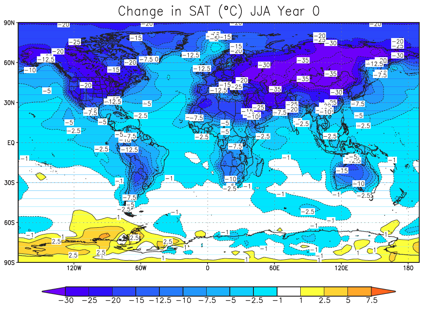
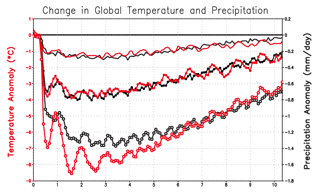
Figure 2. This graph shows the change in average temperature in red, and the change in average rainfall in black each year after the nuclear event. These predictions do not include the changes to the climate system which could occur due to feedback from the biosphere or to extreme value events triggered by the massive release of smoke (Robock 2007).
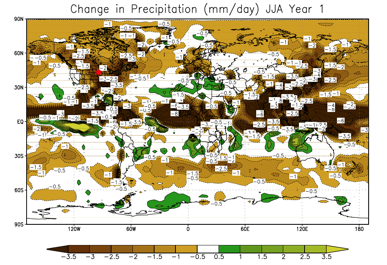
Figure 3. This map shows the change in Precipitation averaged over the first year, in terms of millimeters per day (Robock et al 2007).
After the initial atmospheric and surface temperature changes caused by smoke, further climate effects are created by snow and sea ice feedback. With increased snow fall from colder weather further cooling is produced by snow due to the greater reflectivity of the snow (Robock 1983). This feedback increases the severity of the cooling period following a minor nuclear exchange. Severe cooling results in the destruction of arable lands and a decrease in fresh water supplies, which could potentially last for a generation, wiping out both societies and species. The specific effects related to famine will be discussed in a later section. However, further climatic effects occur even as if the system begin to recover towards a stable state.
As the dust begins to settle, and the initial cooling period occurs, the arbitrary and uncertain nature of a nuclear exchange become even more profound, indiscriminant, and uncertain. The potential long term climate consequences of the loss of vegetation due to lost sunlight are unknown. While the overall, immediate effect of nuclear winter is global cooling, the elevated levels of anthropogenic CO2 already in the atmosphere, as well as the destruction of the global capacity to convert CO2 to oxygen photosynthetically, could lead to a sudden warming after cooling has occurred. This would be a result of the green house gases such as NOx and CO2 released from the aftermath of detonation, as well as the inability of the earth system to adapt to changing green house gas levels. This further uncertainty has not been well explored in the literature, but would undoubtedly only strengthen the argument against the threat and use of Nuclear Weapons.
It is possible, given the hypothetical heavy reliance of a post-apocalyptic society on more primitive technologies which emit large amounts of green house gasses, and the lack of any other natural energy source such as the sun, for many years after the blast, the amount of Green House Gasses in the atmosphere would likely increase. With a lack of carbon fixing organism on the planet, as well as a lack of a carbon sink in the ocean due to the already high levels of CO2 in the pre-detonation climate system, a sudden, and perhaps unstoppable heating may occur when sunlight can again penetrate the atmosphere.
Further environmental problems would be caused by (nitrogen oxides) NO2, and other chemicals such as chloroflorocarbons and halogens that break down ozone, as well as the release of CO2 and other greenhouse gasses; these effects would cause problems which could exceed the nuclear winter scenario. Aerosols produced by Nuclear detonation end up much higher than typical volcanic aerosols (Stenchikov et al., 1998). These aerosols lead to catalytic reactions with ozone in the stratosphere, which results in the conversion of ozone to elemental oxygen. After the first 5 years of a nuclear conflict in which there were just 50 Hiroshima sized warheads detonations, a total ozone depletion between 25% to 45% occurs in the mid latitudes, and up to 70% in the high latitudes.
The majority of the effect occurs because of extended heating of the stratosphere by the black smoke particles which absorb the sunlight. These changes also occur because of increased production of NOx as well as smoke, and last for 5 years before beginning to decline. (Miller et al 2007). With respect to the norms of military operations, the damage which results from a depleted ozone layer is well known and is both indiscriminate and disproportional, while also failing the test of necessity.
Agricultural Effects:
The effects of an abrupt shift in climate would affect most land-based plants, shortening growing seasons and reducing arable land to levels unseen since the last Ice Age. Steven Starr (2009) gives a good analysis of the agricultural effects of even a small nuclear conflict, such as one that may develop between India and Pakistan, in which 100 15 kiloton Hiroshima sized bombs were detonated. Growing seasons would be eliminated and temperatures would be colder than those in the last Ice Age with growing seasons eliminated for at least ten years. Wheat production throughout the world would drastically drop and an estimated 1 billion people would suffer from famine (LCNP 2008).
A full-scale nuclear attack would produce climatic effects which would so disrupt the food supply that it would be self destructive for the country to strike first (Robock, 1989) and would also impact non-combatant countries (Robock et al 2007). These agricultural effects would likely qualify as genocide. Even more, the loss of global vegetation would also have destabilizing effects upon the global climate system, leading to unpredictable changes in climate and even possibly a drastic change.
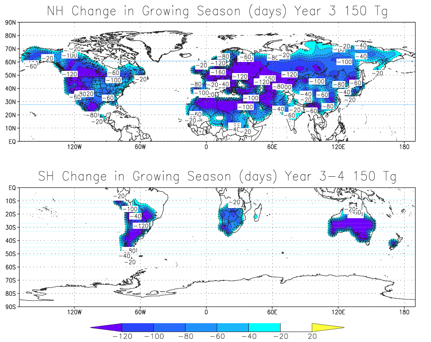
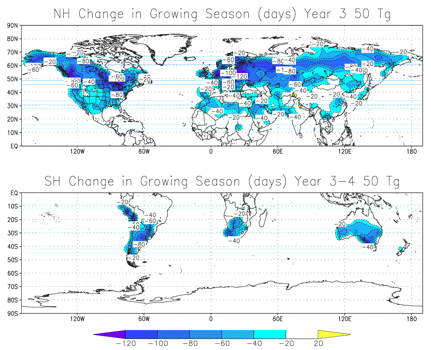
Conclusion
In conclusion, given the severity of secondary consequences of a nuclear conflict, as well as the widespread devastation such a conflict would spread, there can be no conceivable military advantage to be gained from the use. The military position of any country, which initiates a nuclear conflict, or retaliates in one, would be reduced to virtually nothing, as organized infrastructure and society would collapse under the strain of general global famine and migration. Proportionality and necessity are violated, as the total destruction of arable land for much of the world’s population is neither proportional to any loss of national sovereignty nor strategic loss in position if nuclear weapons were not used.
Finally global famine does not distinguish against civilians and combatants, or any living thing for that matter. And global climate change would occur to a far more devastating degree than global warming. Climate change and Nuclear weapons should be a linked topic, since the unrest and instability to states, caused by the consequences of climate change, will likely result in an increased probability of nuclear detonations, and resulting nuclear retaliations, which would change the concern over global warming, for a desperate desire for some global warming to occur.
In the last decade, with the explosion in computing technology, even more uncertainty has been eliminated from the studies, and in most instances, the results of these studies predicted more devastating results, regardless of changes in assumptions. This demonstrates the robustness of the initial predictions and models of the 1980s and further underscores the illegitimacy of the threat and use of nuclear weapons. 50 10 mt bombs should be enough to destroy global political stability. Any more may just be wasteful pork, or fodder for terrorists. It is in the interest of all people to limit arsenals to this size, allowing for a credible deterrence, while lowering the risk for accidental detonations and terrorist acts.
Bibliography:
Aleksandrov, V. V., and G. L. Stenchikov (1983), On the modeling of the climatic consequences of the nuclear war, Proc. Appl. Math, 21 pp., Comput. Cent., Russ. Acad. of Sci., Moscow.
Covey, C., S. Thompson, and S. H. Schneider (1984), Global atmospheric effects of massive smoke injections from a nuclear war: Results from general circulation model simulations, Nature, 308, 21–25.
Crutzen, P. J., and J. W. Birks (1982), The atmosphere after a nuclear war: Twilight at noon, Ambio, 11, 114–125.
ICJ Opinion on Legality and Threat of Nuclear Weapons Article 27. http://www.icj-cij.org/docket/index.php?p1=3&p2=4&k=e1&PHPSESSID=cd4865b....
Martin, B. (1988), Nuclear winter: science and politics, Sci. Public Policy, 15(5), 321–334.
Miller, R. L., G. A. Schmidt, and D. Shindell (2007), Forced annular variations in the 20th century IPCC AR4 models, J. Geophys. Res., 111, D18101, doi:10.1029/2005JD006323.
LCNP (2008) http://www.lcnp.org/wcourt/opinion.htm.
Robock, A. (1983), Snow and ice feedbacks prolong effects of nuclear winter, Nature, 310, 667–670.
Robock, A. (1988), Policy implications of nuclear winter and ideas for solutions, Ambio, 18, 360–366.
Robock, A., L. Oman, and G. L. Stenchikov (2007), Nuclear winter revisited with a modern climate model and current nuclear arsenals: Still catastrophic consequences, J. Geophys. Res., 112, D13107, doi:10.1029/2006JD008235.
Robock, A., L. Oman, G. L. Stenchikov, O. B. Toon, C. Bardeen, and R. P.
Turco (2007b), Climatic consequences of regional nuclear conflicts, Atmos. Chem. Phys., 7, 2003 – 2012.
Starr, Steven (2009). Catastrophic Climatic Consequences of Nuclear Conflict. From the INESAP Bulletin 28, April 2008.
http://www.icnnd.org/research/Starr_Nuclear_Winter_Oct_09.pdf
Stenchikov, G. L., et al. (1998), Radiative forcing from the 1991 Mount Pinatubo volcanic eruption, J. Geophys. Res., 103, 13,837–13,857.
Thompson, Starley L. and Stephen H. Schneider Nuclear Winter Reappraised Foreign Affairs, Vol. 64, No. 5 (Summer, 1986), pp. 981-1005
Turco, R. P., O. B. Toon, T. P. Ackerman, J. B. Pollack, and C. Sagan (1991), Climate and smoke: An appraisal of nuclear winter, Science, 247, 166 – 176.
Turco, R. P., O. B. Toon, T. P. Ackerman, J. B. Pollack, and C. Sagan (1983), Nuclear winter: Global consequences of multiple nuclear explosions, Science, 222, 1283–1292.
The Opinions of the International Court of Justice on the Threat or Use of Nuclear Weapons Michael J. Matheson The American Journal of International Law Vol. 91, No. 3 (Jul., 1997), pp. 417-435 Published by: American Society of International Law Stable URL: http://www.jstor.org/stable/2954181
Yearbook of International Humanitarian Law APPLYING THE RULE OF PROPORTIONALITY: FORCE PROTECTION AND CUMULATIVE ASSESSMENT IN INTERNATIONAL LAW AND MORALITY Yearbook of International Humanitarian Law (2004), 7: 79-112 Cambridge University Press. doi: 10.1017/S1389135904000790 (About doi)
http://www.fas.org/irp/doddir/usaf/afpam14-210/part20.htm#page180 USAF INTELLIGENCE TARGETING GUIDE AIR FORCE PAMPHLET 14- 210 Intelligence 1 FEBRUARY 1998






Comments